Development of a Metaverse Art Gallery of Image Chronicles (MAGIC) for Healthcare Education: A Digital Health Humanities Approach to Patients’ Medication Experiences
Abstract
1. Introduction
2. Materials and Methods
2.1. Design and Development of the Metaverse Art Gallery of Image Chronicles (MAGIC)
2.2. Alpha Testing of MAGIC
2.2.1. Research Model
2.2.2. Statistical Analysis
3. Results
3.1. The Three MAGIC Realms
3.2. Learners’ Demographics and Perceptions of MAGIC
3.3. TAM Scale Reliability
3.4. Learners’ Perceptions of MAGIC
3.5. Correlation of TAM Measures with Participants’ Behavioral Intention to Use MAGIC
4. Discussion
5. Limitations and Future Work
6. Conclusions
Author Contributions
Funding
Data Availability Statement
Conflicts of Interest
References
- British Association of Art Therapists. Art Therapy. British Association of Art Therapists. 2023. Available online: https://baat.org/art-therapy/ (accessed on 19 April 2023).
- American Art Therapy Association. About art Therapy. American Art Therapy Association. 2022. Available online: https://arttherapy.org/about-art-therapy/ (accessed on 19 April 2023).
- Hu, J.; Zhang, J.; Hu, L.; Yu, H.; Xu, J. Art therapy: A complementary treatment for mental disorders. Front. Psychol. 2021, 12, 686005. [Google Scholar] [CrossRef] [PubMed]
- American Art Therapy Association. Ethical Principles for Art Therapists; American Art Therapy Association: Alexandria, VA, USA, 2013; pp. 1–16. [Google Scholar]
- Malchiodi, C.A. Who owns the art? An ethical question for art therapists and clinicians. In Educational Resources Information Center (ERIC) Facility Report, US Department of Education; Educational Resources Information Center (ERIC) Facility, US Department of Education: Salt Lake, UT, USA, 1995; pp. 1–7. [Google Scholar]
- Miller, G.; McDonald, A. Online art therapy during the COVID-19 pandemic. Int. J. Art Ther. 2020, 25, 159–160. [Google Scholar] [CrossRef]
- Hacmun, I.; Regev, D.; Salomon, R. The principles of art therapy in virtual reality. Front. Psychol. 2018, 9, 2082. [Google Scholar] [CrossRef]
- Hogenmiller, M. How Art and Technology Can Work Together to Facilitate Healing. Arts Management & Technology Laboratory, Carnegie Mellon University. 2021. Available online: https://amt-lab.org/blog/2021/11/art-therapy-meets-the-metaverse-how-can-art-and-technology-work-together-to-facilitate-healing (accessed on 19 April 2023).
- Korp, A. What the brain shows: The benefits of virtual reality in creative arts therapies. In Drexel News; Drexel University: Philadelphia, PA, USA, 2021. [Google Scholar]
- McKinsey & Company. What is generative AI? 2023. Available online: https://www.mckinsey.com/featured-insights/mckinsey-explainers/what-is-generative-ai (accessed on 27 April 2023).
- Edwards, R.M.; I’Anson, J. An innovative method of data analysis: Using art as a lens through which to view pharmacy undergraduate students’ learning and assessment practices. Res. Soc. Adm. Pharm. 2022, 18, 2213–2221. [Google Scholar] [CrossRef]
- Kear, J. Pierre Bonnard Coffee 1915. 2016. Available online: https://www.tate.org.uk/art/artworks/bonnard-coffee-n05414 (accessed on 27 April 2023).
- Bronfenbrenner, U.; Morris, P.A. The bioecological model of human development. In Handbook of Child Psychology. Volume I. Theoretical Models of Human Development; John Wiley & Sons: Hoboken, NJ, USA, 2007; Volume I, pp. 793–828. [Google Scholar]
- Charon, R. The patient-physician relationship. Narrative medicine: A model for empathy, reflection, profession, and trust. JAMA 2001, 286, 1897–1902. [Google Scholar] [CrossRef]
- Velazco, C. Mark Zuckerberg Just Laid Out His Vision for the Metaverse. These are the Five Things you Should Know. The Washington Post. 2021. Available online: https://www.washingtonpost.com/technology/2021/10/28/facebook-meta-metaverse-explained/ (accessed on 29 June 2024).
- Wiles, J. What Is a Metaverse? And Should You Be Buying It? Gartner. 2022. Available online: https://www.gartner.com/en/articles/what-is-a-metaverse (accessed on 16 January 2023).
- Mesko, B. The promise of the metaverse in cardiovascular health. Eur. Heart J. 2022, 43, 2647–2649. [Google Scholar] [CrossRef]
- Gupta, A. What is a Metaverse? Gartner Inc. 2022. Available online: https://www.gartner.com.au/en/articles/what-is-a-metaverse (accessed on 14 September 2022).
- Hennig-Thurau, T.; Aliman, D.N.; Herting, A.M.; Cziehso, G.P.; Linder, M.; Kübler, R.V. Social interactions in the metaverse: Framework, initial evidence, and research roadmap. J. Acad. Mark. Sci. 2023, 51, 889–913. [Google Scholar] [CrossRef]
- Kye, B.; Han, N.; Kim, E.; Park, Y.; Jo, S. Educational applications of metaverse: Possibilities and limitations. J. Educ. Eval. Health Prof. 2021, 18, 32. [Google Scholar] [CrossRef]
- Koo, H. Training in lung cancer surgery through the metaverse, including extended reality, in the smart operating room of Seoul National University Bundang Hospital, Korea. J. Educ. Eval. Health Prof. 2021, 18, 33. [Google Scholar] [CrossRef] [PubMed]
- Ahmad, A.B.; Tan, S.; Yap, K. The Saltomachy War—A metaverse escape room on the War Against Salt. Stud. Health Technol. Inform. 2024, 310, 1251–1255. [Google Scholar]
- Yap, K. Developing a digital health metacademy for continuing professional education. Stud. Health Technol. Inform. 2024, 310, 1536–1537. [Google Scholar]
- Chamola, V.; Bansal, G.; Das, T.K.; Hassija, V.; Reddy, N.S.S.; Wang, J.; Zeadally, S.; Hussain, A.; Yu, F.R.; Guizani, M.; et al. Beyond reality: The pivotal role of generative AI in the metaverse. arXiv 2023. [Google Scholar] [CrossRef]
- Shahriar, S. GAN computers generate arts? A survey on visual arts, music, and literary text generation using generative adversarial network. Displays 2022, 73, 102237. [Google Scholar] [CrossRef]
- Cao, Y.; Li, S.; Liu, Y.; Yan, Z.; Dai, Y.; Yu, P.S.; Sun, L. A comprehensive survey of AI-generated content (AIGC): A history of generative AI from GAN to ChatGPT. arXiv 2023, arXiv:2303.04226. [Google Scholar]
- Lathan, C. Generative AI in the Metaverse. Psychology Today. 2023. Available online: https://www.psychologytoday.com/us/blog/inventing-the-future/202306/generative-ai-in-the-metaverse (accessed on 4 October 2023).
- Ursachi, G.; Horodnic, I.A.; Zait, A. How reliable are measurement scales? External factors with indirect influence on reliability estimators. Procedia Econ. Financ. 2015, 20, 679–686. [Google Scholar] [CrossRef]
- Davis, F.D. Perceived usefulness, perceived ease of use, and user acceptance of information technology. MIS Q. 1989, 13, 319–340. [Google Scholar] [CrossRef]
- Davis, F.D.; Granić, A. The Technology Acceptance Model—30 Years of TAM; Springer: Cham, Switzerland, 2024; pp. 1–117. [Google Scholar]
- Venkatesh, V.; Bala, H. Technology Acceptance Model 3 and a research agenda on interventions. Decis. Sci. 2008, 39, 273–315. [Google Scholar] [CrossRef]
- Aburbeian, A.M.; Owda, A.Y.; Owda, M. A Technology Acceptance Model survey of the metaverse prospects. AI 2022, 3, 285–302. [Google Scholar] [CrossRef]
- Gagnon, M.P.; Orruno, E.; Asua, J.; Abdeljelil, A.B.; Emparanza, J. Using a modified technology acceptance model to evaluate healthcare professionals’ adoption of a new telemonitoring system. Telemed. J. E Health 2012, 18, 54–59. [Google Scholar] [CrossRef]
- Toraman, Y.; Gecit, B.B. User acceptance of metaverse: An analysis for e-commerce in the framework of Technology Acceptance Model (TAM). Sosyoekonomi 2023, 31, 85–104. [Google Scholar] [CrossRef]
- Alsharhan, A.; Salloum, S.A.; Aburayya, A. Technology acceptance drivers for AR smart glasses in the middle east: A quantitative study. Int. J. Data Netw. Sci. 2022, 6, 193–208. [Google Scholar] [CrossRef]
- Suh, W.; Ahn, S. Utilizing the Metaverse for Learner-Centered Constructivist Education in the Post-Pandemic Era: An Analysis of Elementary School Students. J. Intell. 2022, 10, 17. [Google Scholar] [CrossRef] [PubMed]
- Mostafa, L. Measuring Technology Acceptance Model to use metaverse technology in Egypt. J. Smart Sci. Technol. 2022, 23, 118–142. [Google Scholar] [CrossRef]
- Hair, J.F., Jr.; Black, W.C.; Babin, B.J.; Anderson, R.E. Multivariate Data Analysis, 7th ed.; Pearson College Div: Saddle River, NJ, USA, 2009; p. 785. [Google Scholar]
- Three-Body Problem. Wikipedia. 2024. Available online: https://en.wikipedia.org/wiki/Three-body_problem (accessed on 5 April 2024).
- Devine, S. Therapeutic impact of public art exhibits during COVID-19. Art Ther. 2022, 40, 50–54. [Google Scholar] [CrossRef]
- Vick, R.M. Ethics on exhibit. Art Ther. 2011, 28, 152–158. [Google Scholar] [CrossRef]
- Al-Adwan, A.S.; Li, N.; Al-Adwan, A.; Abbasi, G.A.; Albelbisi, N.A.; Habibi, A. Extending the Technology Acceptance Model (TAM) to predict university students’ intentions to use metaverse-based learning platforms. Educ. Inf. Technol. 2023, 28, 15381–15413. [Google Scholar] [CrossRef] [PubMed]
- Kalinkara, Y.; Ozdemir, O. Anatomy in the metaverse: Exploring student technology acceptance through the UTAUT2 model. Anat. Sci. Educ. 2024, 17, 319–336. [Google Scholar] [CrossRef]
- Ren, L.; Yang, F.; Gu, C.; Sun, J.; Liu, Y. A study of factors influencing Chinese college students’ intention of using metaverse technology for basketball learning: Extending the technology acceptance model. Front. Psychol. 2022, 13, 1049972. [Google Scholar] [CrossRef]
- Ostherr, K. Digital Health Humanities. In Research Methods in Health Humanities; Klugman, C.M., Lamb, E.G., Eds.; Oxford University Press: New York, NY, USA, 2019; pp. 182–198. [Google Scholar]
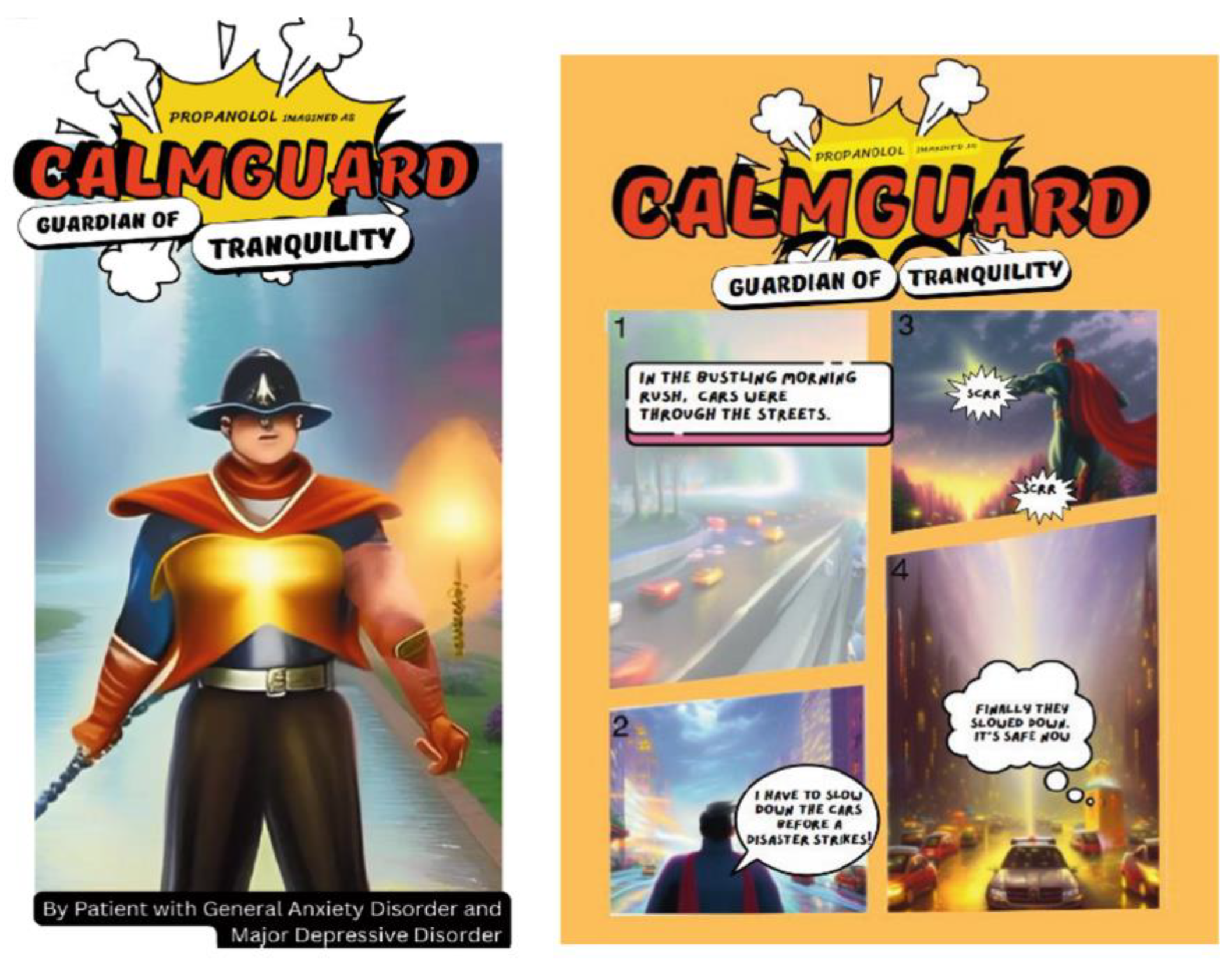
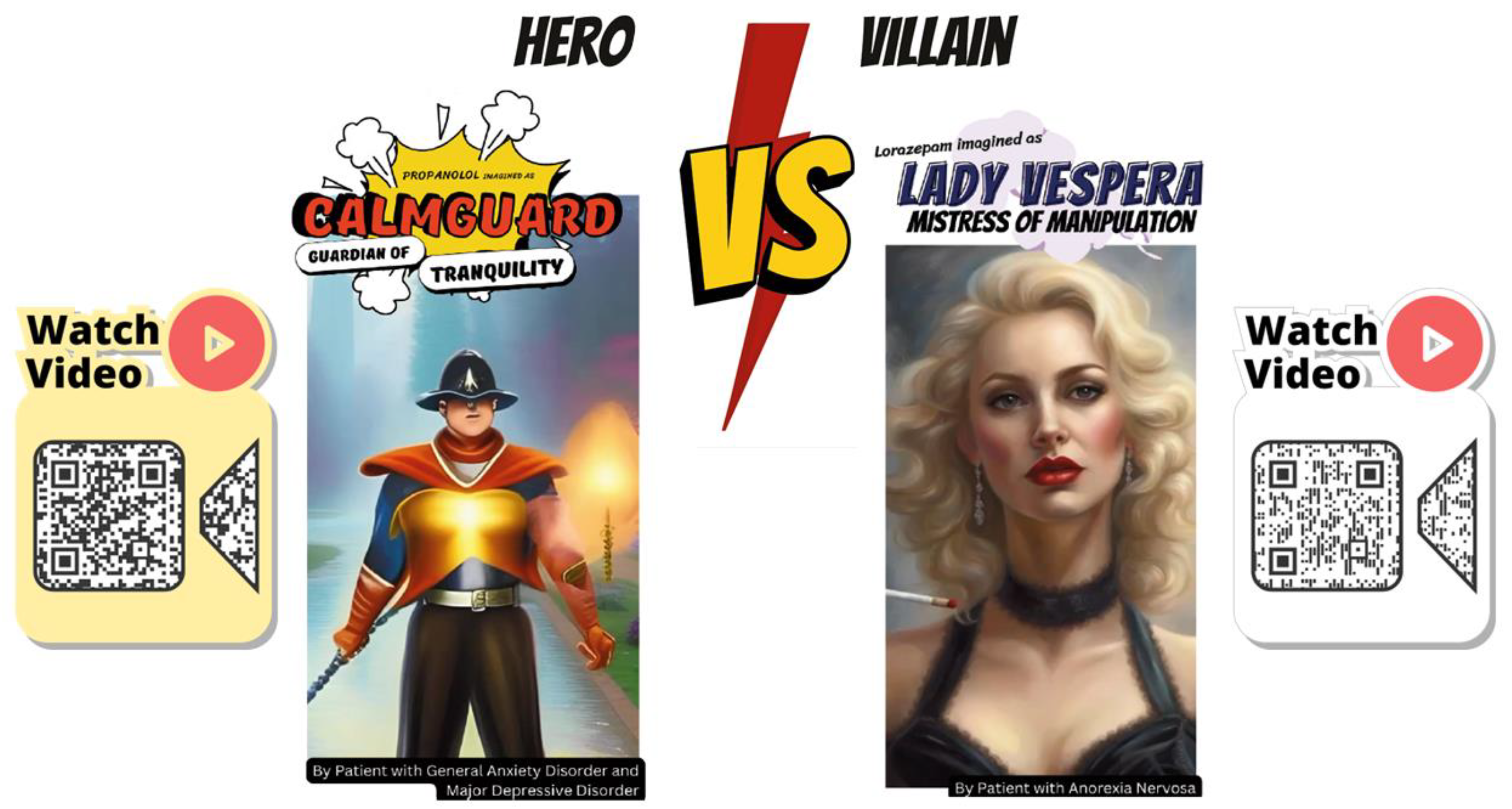
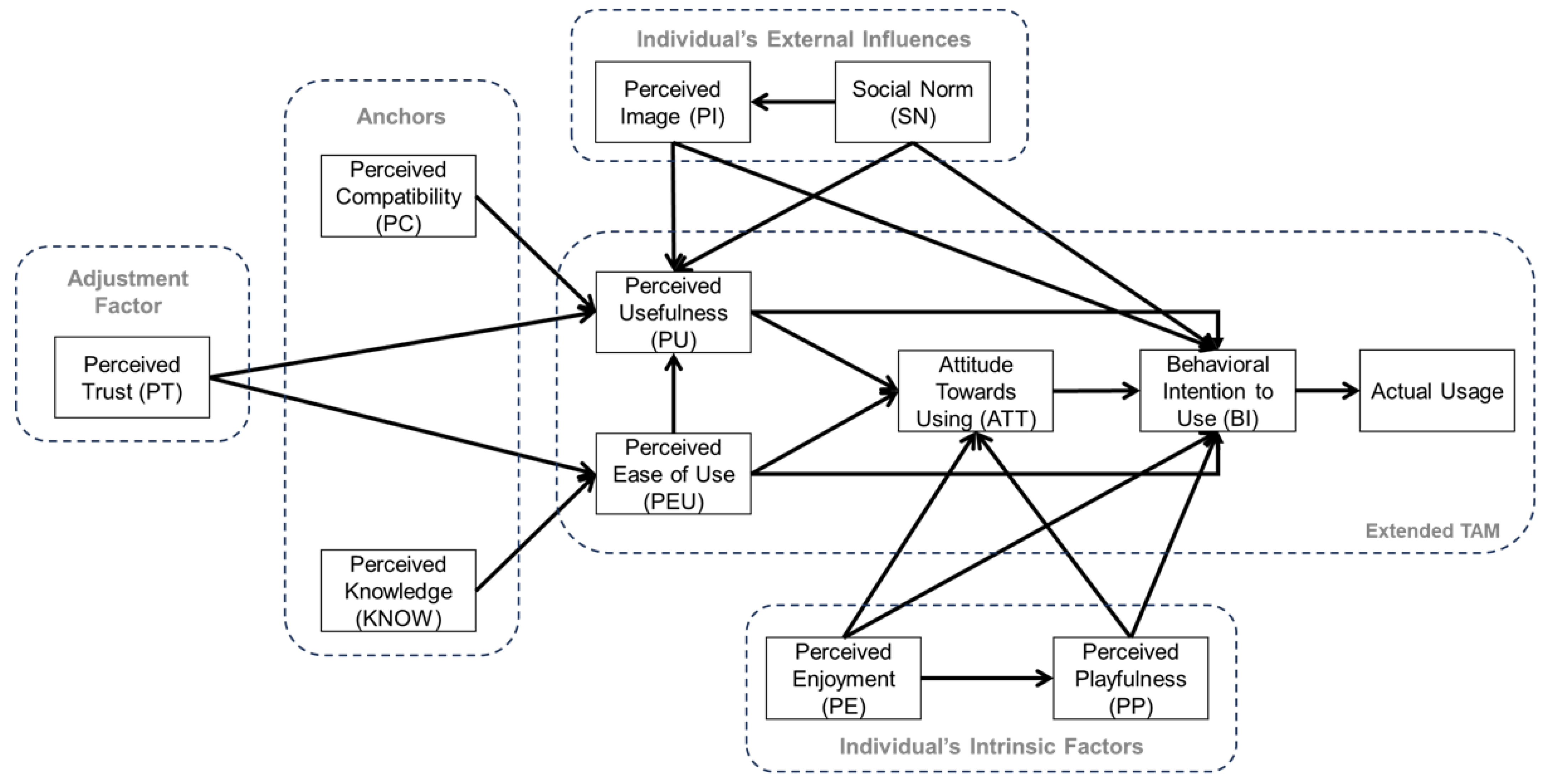
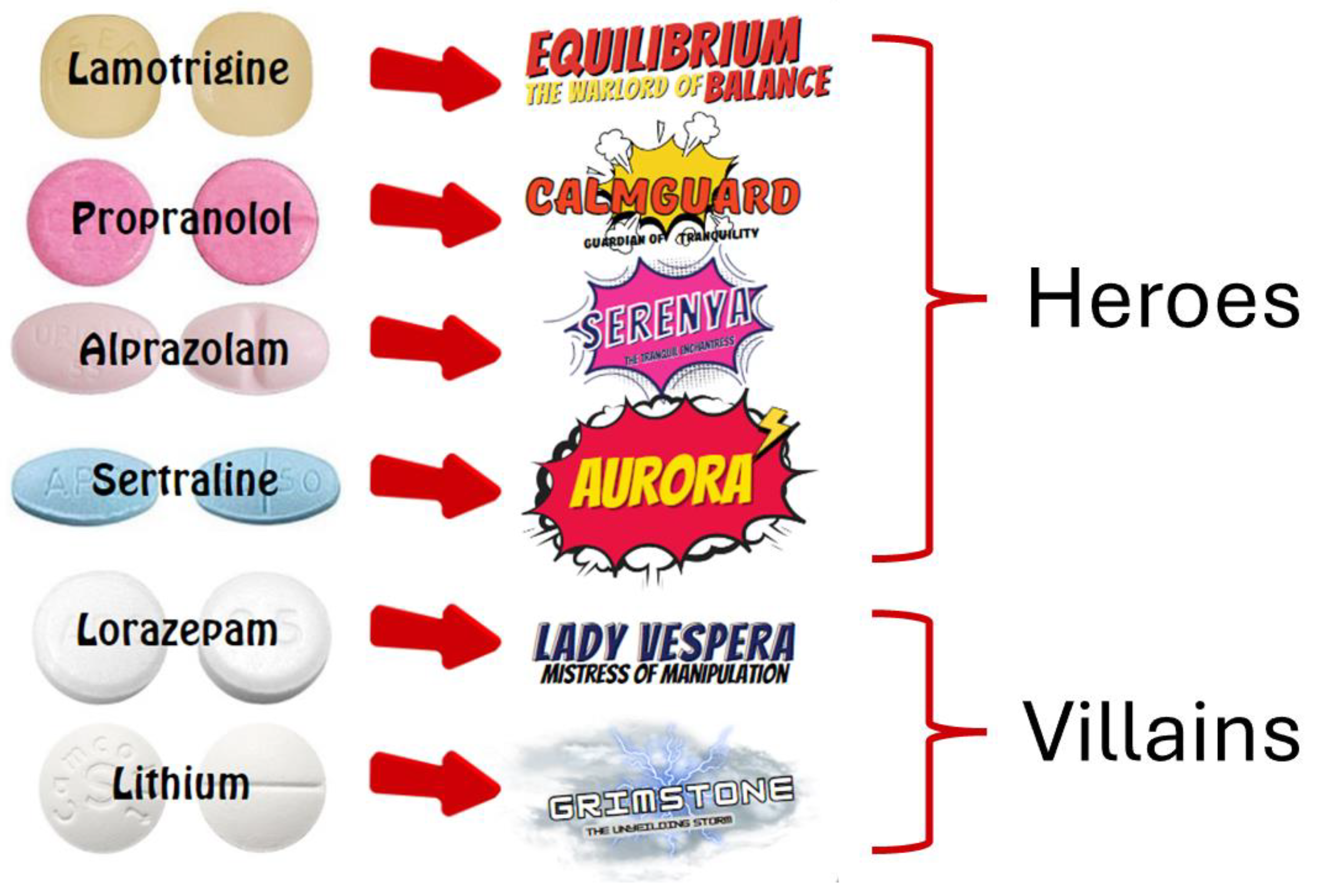
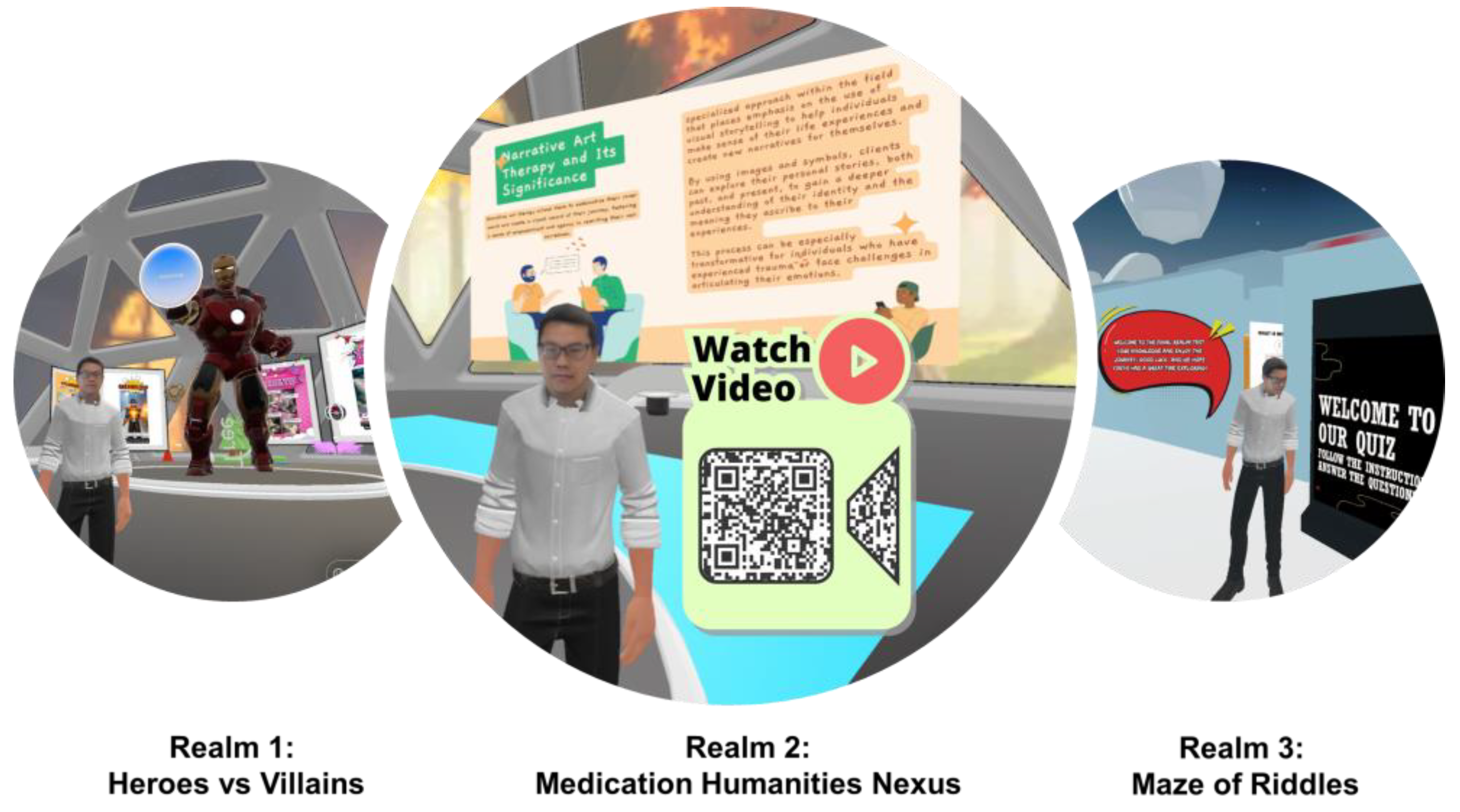
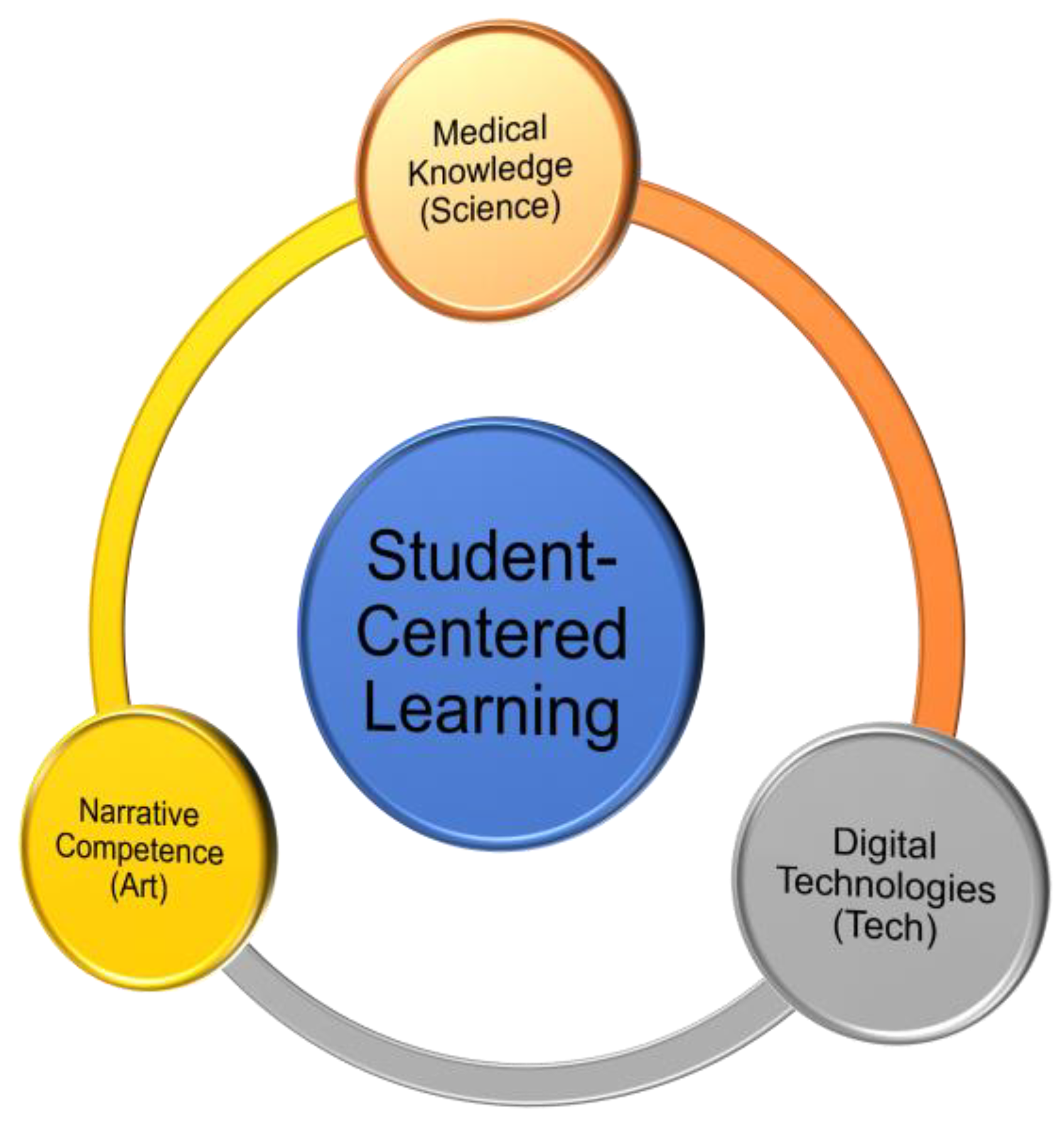
| Demographics of Participants | Number of Participants (%) |
|---|---|
| Gender: | |
| Male | 5 (31.3) |
| Female | 11 (68.8) |
| Specialization: | |
| Pharmaceutical Science | 12 (75.0) |
| Pharmacy | 4 (25.0) |
| Age Generation: | |
| Gen Z (1997–2009) | 16 (100.0) |
| Healthcare Practice Experience: | |
| No working experience | 11 (68.8) |
| Fresh graduate (<1 year) | 4 (25.0) |
| 1–5 years | 1 (6.3) |
| Digital Knowledge and Skills: | |
| Sharing and interacting online: | |
| Confident a+ | 11 (68.8) |
| Not very confident b+ | 1 (6.3) |
| Managing safety and well-being online: | |
| Confident a+ | 10 (62.5) |
| Not very confident b+ | 2 (12.5) |
| Adapting to new technology: | |
| Confident a+ | 10 (62.5) |
| Not very confident b+ | 2 (12.5) |
| Digital content creation: | |
| Confident a | 8 (50.0) |
| Not very confident b | 8 (50.0) |
| Metaverse experience prior to accessing MAGIC: ^ | |
| Augmented reality (e.g., Pokemon Go, Snow app) | 15 (93.8) |
| Lifelogging (e.g., Instagram, Facebook, Twitter (X), Tiktok) | 14 (87.5) |
| Mirror Worlds (e.g., Google Earth, Zoom, Microsoft Teams, Skype) | 15 (93.8) |
| Virtual Worlds (e.g., Second Life, Fortnite, Minecraft, Roblox, ZEPETO) | 12 (75.0) |
| Content in MAGIC | Number of Participants (%) |
|---|---|
| Favorite Character Portrait: | |
| Hero Portraits: | |
| Lamotrigine (Equilibrium—Warlord of Balance) | 1 (6.3) |
| Propranolol (Calmguard—Guardian of Tranquility) | 5 (31.3) |
| Alprazolam (Serenya—Tranquil Enchantress) | 2 (12.5) |
| Sertraline (Aurora—Artistic Alchemist) | 3 (18.8) |
| Villain Portraits: | |
| Lorazepam (Lady Vespera—Mistress of Manipulation) | 4 (25.0) |
| Lithium (Grimstone—Unyielding Storm) | 1 (6.3) |
| Reason for Favorite Character: | |
| Tells me more about patient’s viewpoint about medication | 1 (6.3) |
| Teaches me more about mechanism of action of medication | 4 (25.0) |
| Correlates another viewpoint of art therapy and medication adherence | 1 (6.3) |
| Allows me to learn more about medication in general | 5 (31.3) |
| Helps me in medication counselling practice | 1 (6.3) |
| Provides a realistic analogy of patient’s medication experience | 4 (25.0) |
| Rating of Content in MAGIC: a | |
| Understanding of art therapy: | |
| Informative b | 14 (87.5) |
| Not very informative c | 2 (12.5) |
| Understanding of medication adherence: | |
| Informative b | 15 (93.7) |
| Not very informative c | 1 (6.3) |
| Understanding how patients relate to their medications: | |
| Informative b | 13 (81.3) |
| Not very informative c | 3 (18.8) |
| Interest in Learning More about Art Therapy and Narrative Storytelling: d | |
| Interested d | 10 (62.5) |
| Not very interested e | 6 (37.5) |
| TAM Measures | Number of Items/Statements | Cronbach’s Alpha (α) |
|---|---|---|
| Perceived Enjoyment (PE) | 2 | 0.639 |
| Perceived Usefulness (PU) | 3 | 0.670 |
| Perceived Playfulness (PP) | 4 | 0.760 |
| Perceived Trust (PT) | 3 | 0.857 |
| Perceived Knowledge (KNOW) | 2 | 0.414 |
| Social Norm (SN) | 3 | 0.746 |
| Perceived Compatibility (PC) | 3 | 0.787 |
| Perceived Image (PI) | 3 | 0.936 |
| Perceived Ease of Use (PEU) | 4 | 0.633 |
| Attitude Towards Use (ATT) | 3 | 0.910 |
| Behavioral Intention (BI) | 3 | 0.735 |
| Overall Total | 33 | 0.943 |
| TAM Measures | TAM Parameters/Statements | Scores for TAM Statements a (Average ± SD) | Average Score for TAM Measures a (Average ± SD) |
|---|---|---|---|
| Perceived Enjoyment (PE) |
| 6.31 ± 0.70 | 6.13 ± 0.67 |
| 5.94 ± 0.85 | ||
| Perceived Usefulness (PU) |
| 5.94 ± 0.93 | 5.85 ± 0.72 |
| 6.13 ± 0.62 | ||
| 5.50 ± 1.16 | ||
| Perceived Playfulness (PP) |
| 6.25 ± 0.78 | 5.80 ± 0.71 |
| 5.06 ± 1.18 | ||
| 5.75 ± 1.07 | ||
| 6.13 ± 0.62 | ||
| Perceived Trust (PT) |
| 5.69 ± 0.79 | 5.77 ± 0.88 |
| 5.81 ± 1.05 | ||
| 5.81 ± 1.11 | ||
| Perceived Knowledge (KNOW) |
| 5.56 ± 0.81 | 5.66 ± 0.72 |
| 5.75 ± 1.00 | ||
| Social Norm (SN) |
| 5.69 ± 0.79 | 5.46 ± 0.85 |
| 5.56 ± 1.03 | ||
| 5.13 ± 1.26 | ||
| Perceived Compatibility (PC) |
| 5.44 ± 1.03 | 5.44 ± 0.96 |
| 5.13 ± 1.41 | ||
| 5.75 ± 0.93 | ||
| Perceived Image (PI) |
| 5.13 ± 1.20 | 5.19 ± 1.15 |
| 5.31 ± 1.14 | ||
| 5.13 ± 1.31 | ||
| Perceived Ease of Use (PEU) |
| 5.81 ± 0.91 | 5.11 ± 0.42 |
| 5.44 ± 0.89 | ||
| 3.25 ± 1.73 | ||
| 5.94 ± 0.85 | ||
| Attitude Towards Use (ATT) c |
| 5.44 ± 0.81 | 5.67 ± 0.82 |
| 5.75 ± 0.86 | ||
| 5.81 ± 0.98 | ||
| Behavioral Intention (BI) |
| 5.81 ± 0.91 | 5.81 ± 0.79 |
| 5.69 ± 1.14 | ||
| 5.94 ± 0.85 |
| TAM Measures a | Spearman’s Correlation Coefficient (rs) b | p-Value | 95% Confidence Interval | Exploratory Factor Analysis | ||
|---|---|---|---|---|---|---|
| Factor 1 Loadings | Factor 2 Loadings | Extraction Communalities c | ||||
| Perceived Enjoyment (PE) | 0.608 | 0.012 * | 0.114, 0.861 | 0.583 | 0.535 | 0.627 |
| Perceived Usefulness (PU) | 0.789 | <0.001 * | 0.419, 0.934 | 0.769 | 0.398 | 0.750 |
| Perceived Playfulness (PP) | 0.925 | <0.001 * | 0.749, 0.979 | 0.890 | 0.291 | 0.877 |
| Perceived Trust (PT) | 0.647 | 0.007 * | 0.171, 0.878 | 0.849 | −0.008 | 0.721 |
| Social Norm (SN) | 0.862 | <0.001 * | 0.582, 0.959 | 0.961 | 0.106 | 0.935 |
| Perceived Compatibility (PC) | 0.890 | <0.001 * | 0.652, 0.968 | 0.975 | −0.007 | 0.951 |
| Perceived Image (PI) | 0.680 | 0.004 * | 0.222, 0.892 | 0.941 | −0.142 | 0.906 |
| Perceived Ease of Use (PEU) | 0.249 | 0.352 | −0.289, 0.668 | −0.112 | 0.917 | 0.853 |
| Attitude Towards Use (ATT) | 0.451 | 0.079 | −0.084, 0.784 | 0.094 | 0.885 | 0.791 |
| Behavioral Intention (BI) | -- | -- | -- | 0.892 | 0.270 | 0.869 |
Disclaimer/Publisher’s Note: The statements, opinions and data contained in all publications are solely those of the individual author(s) and contributor(s) and not of MDPI and/or the editor(s). MDPI and/or the editor(s) disclaim responsibility for any injury to people or property resulting from any ideas, methods, instructions or products referred to in the content. |
© 2024 by the authors. Licensee MDPI, Basel, Switzerland. This article is an open access article distributed under the terms and conditions of the Creative Commons Attribution (CC BY) license (https://creativecommons.org/licenses/by/4.0/).
Share and Cite
Yap, K.Y.-L.; Ho, J.; Toh, P.S.T. Development of a Metaverse Art Gallery of Image Chronicles (MAGIC) for Healthcare Education: A Digital Health Humanities Approach to Patients’ Medication Experiences. Information 2024, 15, 431. https://doi.org/10.3390/info15080431
Yap KY-L, Ho J, Toh PST. Development of a Metaverse Art Gallery of Image Chronicles (MAGIC) for Healthcare Education: A Digital Health Humanities Approach to Patients’ Medication Experiences. Information. 2024; 15(8):431. https://doi.org/10.3390/info15080431
Chicago/Turabian StyleYap, Kevin Yi-Lwern, Jayen Ho, and Phylaine Shu Ting Toh. 2024. "Development of a Metaverse Art Gallery of Image Chronicles (MAGIC) for Healthcare Education: A Digital Health Humanities Approach to Patients’ Medication Experiences" Information 15, no. 8: 431. https://doi.org/10.3390/info15080431
APA StyleYap, K. Y.-L., Ho, J., & Toh, P. S. T. (2024). Development of a Metaverse Art Gallery of Image Chronicles (MAGIC) for Healthcare Education: A Digital Health Humanities Approach to Patients’ Medication Experiences. Information, 15(8), 431. https://doi.org/10.3390/info15080431







